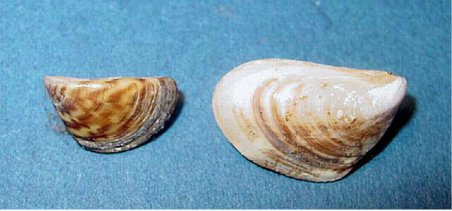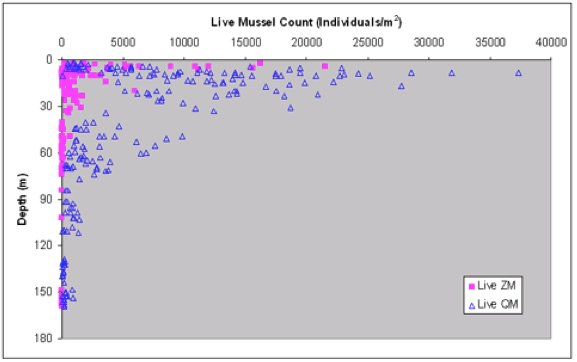Quagga Mussels and Zebra Mussels in Seneca Lake Worksheet
Lesson Introduction
Zebra Mussels (Dreissena polymorpha) were know to have invaded Seneca Lake in the early 1990's, followed soon afterward by the invasion of their distant cousin, the quagga mussel (Dreissena bugensis). Both of these species of mussels come from Eurasia. They are considered invasive because of their potential to cause economic and ecological damage to Seneca Lake. For more information about the impacts of these species see the references listed below.
While participating in Science on Seneca, students will see these mussels in the sediment dredge samples they collect. To distinguish the species you need to look closely at the hinge. Zebra mussels have a flat hinge and lay flat on the palm of your hand while the quagga's hinge is oval shaped and will tip. See the images below to view the different species.

During the summer of 2007, scientists from the Finger Lakes Institute studied the distribution and density of quaggas and zebra mussels in Seneca Lake. The scientists collected dredge samples from over 100 sample sites around the lake. They cleaned and rinsed the samples using screens and counted live vs. dead, quagga and zebra mussels for each sample collected. The power point reference below shows Dr. Bin Zhu, Finger Lakes Institute research scientist, sifting through the sediment sample and rinsing it out to collect the mussels. After collecting the mussels, the scientists then used mathematical formulas to extrapolate the densities of mussels per square meter. Graph 1 below shows the densities of live quagga and zebra mussels at different depths in Seneca Lake.
Graph 1 - Quagga and Zebra Mussel Densities in Seneca Lake

QM= Quagga Mussels
Activity
Using the information in the lesson introduction, the linked essay on zebra and quagga mussels, the facts sheetsfrom the USGS; answer these questions.
- After viewing graph 1 - what can you say about the distribution of quagga versus zebra mussels in the lake? Which species is more abundant?
- Why do scientists study zebra and quagga mussels in lake systems?
- How do adaptations of these species influence their ability to out compete other native species?
- How do these species compete with each other?
- From the reading, name three factors that allow quagga mussels to out-compete the zebra mussels in Seneca Lake.
